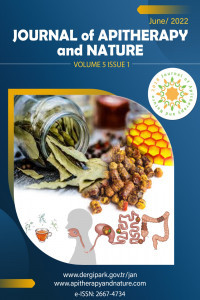Mechanistic Studies of Cytotoxicity Induced by a Portuguese Propolis Extract, Using Saccharomyces cerevisiae as Eukaryotic Cell Model
Mechanistic Studies of Cytotoxicity Induced by a Portuguese Propolis Extract, Using Saccharomyces cerevisiae as Eukaryotic Cell Model
Propolis, Saccharomyces cerevisiae,
___
- 1. Zabaiou N, Fouache A, Trousson A, Baron S, Zellagui A, Lahouel M, Lobaccaro JMA (2017) Chemistry and Physics of Lipids 207: 214-222.
- 2. Cruz M, Antunes P, Paulo L, Ferreira AM, Cunha A, Almeida-Aguiar C, Oliveira R (2016) RSC Advances 55: 49806-49816.
- 3 Bonamigo T, Campos JF, Alfredo TM, Balestieri JBP, Cardoso CAL, Paredes-Gamero EJ, Santos EL (2017) Oxidative Medicine and Cellular Longevity
- Yayın Aralığı: Yılda 2 Sayı
- Başlangıç: 2018
- Yayıncı: Oktay YILDIZ
ARC (Apiceutical Research Centre): Developing a Global BeePharma Network Local Help for Local Health
Chemical Profile and Botanical Origin of Stingless Bee Propolis from Thailand and Indonesia
Chemical Composition of Selected Propolis Samples from Kyrgyzstan and Kazakhstan
Argyro PETROPOULOU, Konstantia GRAIKOU, Jaroslaw WIDELSKI, Krystyna SKALICKA-WOŹNIAK, Zuriyadda SAKIPOVA, İoanna CHINOU
Determination of Propolis Origin Using Phenolic Composition and Artificial Neural Networks
İsabel REVILLA, Ana María VIVAR-QUINTANA, Pedro HERNÁNDEZ-RAMOS
Chemical Profiling of Tropical Propolis: Challenges and New Data
Milana POPOVA, Boryana TRUSHEVA, Kristina GEORGIEVA, Vassya BANKOVA
Determination of Phenolic Acids in Raw Propolis Using Near Infrared Spectroscopy
Ana María VIVAR-QUINTANA, İsabel REVILLA, María İnmaculada GONZÁLEZ-MARTÍN, Eddy Valentín BETANCES-SALCEDO
Anticancer Properties of Aqueous and Nonaqueous Propolis Extracts
Zbigniev BALION, Aistė JEKABSONE, Kristina RAMANAUSKIENE, Daiva MAJIENĖ
Yoga Bee, a New Approach for Health
Propolis: Pharmacological Properties and Medical Applications of Propolis in Modern Medicine
İvan MISKULIN, İvana KLARIC, Matija DOMACINOVIC, Berislav PRAKATUR, Mirela PAVIC, Mario RONTA, Maja MISKULIN
